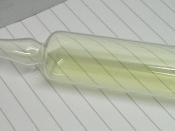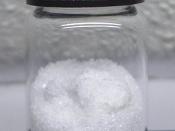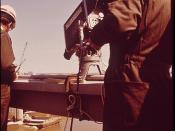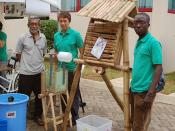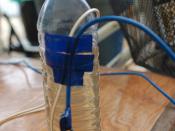AbstractIn this experiment, the research was to see the effects of carbon filters in removing the chlorine from tap water. The research question was to determine how do activated carbon water filtration systems work? What is their capacity to purify water? The purpose of this was to test if water filters really do occupy the capacity stated as well as the removal of substances such as chlorine.
Since chlorine can damage the human body, filters are used to reduce the amount of chlorine within the water. In this experiment, samples of water from the tap and filter were tested. As the experiment proceeded, silver nitrate was used to calculate the amount of chloride ions within the substance. As precipitation occurred when silver nitrate was placed in the water, the Ksp value was used and further calculations determined the amount of chlorine in the water. Further tests could have included looking through microscopic machines that would show when the precipitation occurred and as a result make the lab more precise.
The experiment was to show how much carbon filters removed chloride ions from the water. Also, it was tested if the capacity that water filters can take was either correct or not.
As a result of this experiment, it showed that the filters really do last the capacity given by the manufacturer. However, the amount of chlorine reduced by the product was inefficient as it stated to remove 99% of chlorine in which in this experiment, only around 50% of chlorine was extracted from the water. It is seen that even though around 2ppm of chlorine was reduced in the experiment, it is ÃÂsaferÃÂ to drink filtered water as it reduces the chances of getting debilitated by chlorine.
[295 words]IntroductionWater is a required nutrient for all living organisms. Recommended human consumption is up to 8 glasses of water a day. Untreated water can cause many problems or damage the human body because of the organisms within it. Water is treated with chlorine to prevent the growth of these bacteria or micro-organisms. Chlorine can play a negative role in the body because it or the compounds it forms may be carcinogenic which becomes a more significant factor when large amounts of chlorinated water are consumed. Chlorine gas is dissolved in water though a process involving the compressions of chlorine gas. The compressed gas, now in its liquid form is reacted with water to kill harmful bacteria. Hypochlorous acid and hydrochloric acid are produced when the chlorine reacts with water according to the following equation Cl2+H2O==>HClO+H++Cl- . Since chlorine gas is very toxic, some possibilities of its danger could be caused by accidental release from storage tanks and therefore chlorinated hydrocarbons may form. This is caused by chlorine reacting with carbon or other hydrocarbons. Examples of these substances are dichloromethane, trichloroethylene, and chloroform. Hydrocarbons known as trihalomethanes can produce problems in the liver, central nervous system, and kidneys. According to the Canadian Cancer Society, chlorinated tap water has shown results which produce a high cancer rate in humans, especially cancer of the bladder. However, water filters can be applied to reduce the levels of these potential carcinogens. Since the acceptable level of chlorine in regular tap water is between 2-4ppm (parts per millions), filters may reduce the chlorine consumption by more than half of what is supplied by the average tap water. Many people around the world suffer from diseases that can be caused by polluted tap water. Brita is a water filtering company that proclaims to reduce 2ppm of chlorine. In this experiment, it will be determined whether water filters are effective or not in the reduction of chlorine. The filters will be further tested until it cannot de-chlorinate any more water and thus measures the lifetime of a filter to see the effects as it goes through the activated carbon beds. This experiment will focus on: How do activated carbon water filtration systems work? What is their capacity to purify water?Purpose:The purpose of this experiment is to determine whether filters are effective in daily life or not and to an extent of how much chlorine is reduced by these filters. This is because the amount of chlorine that is consumed for the human body is dangerous; hence reducing the amount through the use of filters would limit the chances of being infected by such elements.
Hypothesis:In this experiment, the hypothesis which can be made for water filters is that they will reduce chlorine as the carbon beds are actively attracting the chlorine ions. The carbon atom will further remove other molecules in water such as fluoride, lead, and asbestos. These chemicals are harmful to the human body, but filters tend to remove large amounts of these hazardous chemicals. The efficiency of a carbon filter can be tested using the precipitation reaction of silver ions with chloride ions. Silver chloride is a highly insoluble salt with a ksp value of 1.6 x 10-10 at 25 degrees Celsius. By testing samples of unfiltered water with silver ions and filtered water with silver ions, the chloride ion concentration can be determined using the solubility product value. It should take more silver ions to precipitate all the chloride ions in the filtered tap water than the unfiltered tap water, since ksp = [Ag+] [Cl-]. Formation of the precipitate will be determined using a laser; the precipitate particles will cause the laser beam to scatter when the particles are large enough to reflect light. This is called the Tyndall effect. The Tyndall effect is ÃÂthe phenomenon in which light is scattered by very small particles in its path; it makes a beam of light visibleÃÂ.
Variables:The variables in this lab are set in three different categories; controlled, manipulated, and dependent. The controlled variables in this experiment are the temperature of the water, the filter used and the source of the water. Another controlled variable is the rate of stirring the solution when precipitation begins to occur. The dependent variable is the chlorine in water. Finally, the independent variable is the Ag+ added to the water sample.
Materials:The materials needed are efficient and required to complete the lab. There is a need for two 40mL beakers. A graduated cylinder of 100mL and another one of 10mL is required. A pipette is necessary in order to drop amounts of AgNO3 into the water. A laser is mandatory to see the reaction between AgNO3 and water. The solution concentration of silver nitrate is vital to the lab as it is the solution that will lead one to further observations. Water (non-filtered and filtered) is also requisite to the experiment.
Safety Precautions:The solution that is harmful to our skin is silver nitrate. It is important that it is handled carefully and none of the substance is consumed. If the solution is accidentally applied to human skin, it is important that the area is washed constantly with water. Wash and rinse area with soap carefully and wipe with towel. Also clean up area when experiment is done or if any solution is spilled. Note that the solution should be covered so there is no risk of random spilling or any other substance involved with the solution.
Method:In order to start the experiment, the equipment must be collected and the experiment must be done with caution in order to have the best results. It is important to rinse out all equipment with distilled water to prevent contamination. When inserting silver nitrate into any substance, it is important to rinse out the equipment the AgNO3 will be in. The main reason is that chlorine may be present within the equipment and hence if silver nitrate is added into the solution, the reaction of precipitation might occur right away. Therefore, instead of having AgNO3 to react with the chloride ions already present, the experiment will be more precise if the materials are rinsed with distilled water. Even when water is placed into beakers, the materials should be washed using distilled water because tap water may leave chlorine contaminants and hence be involved with filtered water which would skew the results.
The next steps are to take the water that is being tested (either filtered water or tap water) and then carefully fill it within the graduated cylinder to 40mL. Once the water is measured in the graduated cylinder, the water should be transferred into a beaker. The beaker is used for better observations. Using the 10mL graduated cylinder, place silver nitrate up to 10mL. The laser light will be used to look through the water once AgNO3 is added as the precipitation begins before the human eye can see it. This is why a laser is placed in a way where the solution is easy to see when adding AgNO3. The experiment can now begin with a pipette. Using the pipette, obtain the solution of silver nitrate within it. The next important step is to drop AgNO3 in a slow rate so there can be precipitation. Using a laser, the precipitation can be seen easily, however when trying to make the substance more cloudy in order to see through the human eye, a lot more of silver nitrate is needed. Once the human eye meets the precipitation from the reaction between the water and the silver nitrate, immediately stop adding silver nitrate. Place the remaining solution within the pipette back into the 10mL graduated cylinder. Measure how many milliliters of silver nitrate were used in the experiment. Write down results and write down the observations of the reactions that took place (precipitation). The remaining AgNO3 in the dropper should be placed back into the 10mL graduated cylinder. Look how much of total solution is in the other graduated cylinder (water and AgNO3) and make notes on how much is taken into account. If further trials are to take place, make sure one does not forget to refill the silver nitrate into the 10mL solution as some of it may be used in the previous experiment. Also a key point is to keep the solution that has just precipitated. This is because when other experiments are being made, the solution can be compared to the one that is already done. By this comparison, results will be more precise as the level of precipitation will be nearly the same. Once the lab is complete, clean up the material and place the remaining silver nitrate back into the bottle. Make sure there is no mess or liquid spilled in the lab area. Place the materials back from belongings and clean up lab area once again.
Observations:Table 1-Qualitative Results:Water (tap water and filtered water)ÃÂClear, colorless, odorlessSilver nitrateÃÂClear, colorlessMixture of water and silver nitrateÃÂLaser beam was pointed through the beaker before silver nitrate was added and light beam was straightÃÂWhen silver nitrate was being added, light became a bit unclearÃÂPrecipitation also started to form when silver nitrate was being added to the water. It was a white cloud within the water at wherever the silver nitrate had dropped in the waterÃÂThis indicated the equilibriumÃÂOnce equilibrium was reached, the light beam split into different directionsTable 2-Quantitative Results:TypeTimeTrialVolume of WaterVolume of AgNO3ppm of ChlorineTap0 hourTrial 140.0 mL4.0 mL4.24 ppmTrial 240.0 mL3.9 mL4.35 ppmTrial 340.0 mL4.0 mL4.24 ppmFilter0 hourTrial 140.0 mL8.0 mL2.14 ppmTrial 240.0 mL8.0 mL2.14 ppmTrial 340.0 mL8.1 mL2.12 ppmFilter0.5 hours after water running constantly through filterTrial 140.0 mL7.8 mL2.20 ppmTrial 240.0 mL7.8 mL2.20 ppmTrial 340.0 mL7.75 mL2.21 ppmFilter1 hours after water running constantly through filterTrial 140.0 mL7.5 mL2.28 ppmTrial 240.0 mL7.5 mL2.28 ppmTrial 340.0 mL7.5 mL2.28 ppmFilter1.5 hours after water running constantly through filterTrial 140.0 mL6.9 mL2.48 ppmTrial 240.0 mL6.9 mL2.48 ppmTrial 340.0 mL6.95 mL2.46 ppmFilter2 hours after water running constantly through filterTrial 140.0 mL5.95 mL2.87 ppmTrial 240.0 mL6.0 mL2.84 ppmTrial 340.0 mL6.0 mL2.84 ppmFilter2.5 hours after water running constantly through filterTrial 140.0 mL5.0 mL3.40 ppmTrial 240.0 mL4.92 mL3.46 ppmTrial 340.0 mL5.0 mL3.4 ppmThe observation of water is clear, tasteless, and odorless. When comparing the experiments between tap water and filtered water, more silver nitrate was required in filtered water. The Brita filter proved to be working to perfection. It had stated that it would reduce up to 2ppm of chlorine. In the calculations, it can be seen that the difference from tap water and the filtered water is 2ppm. The reduction shows that the filter works perfectly fine. Now, when I took into account the amount of time it takes to fill 1L of water. According to Brita, it can only purify/de-chlorinate about 378litres of water. In the experiment, the flow rate of the water was tested. Since it took about 20.39 seconds to fill up a liter through the filter, calculations were done to experiment how long the tap water should be running until it stops working. Since the flow rate of the filter water was 20.39 seconds per liter, it would take 2.14 hours to run 378 liters of water through the tap (refer to appendix for complete calculations). When the experiment was being performed, water samples were taken every 30 minutes. The difference was seen throughout the timings. The experiment indicated that filter replacement was required after 2.14 hours to perform as well as it performed earlier when filter was first used. When water was being tested; there was very little difference between the chlorine levels in ppm.
During the experiment, many trials were taken and after water had passed through the filter after a great amount of water, the results started to change. The amount of chlorine that was present in the beginning of the experiment was less than the amount of chlorine in the experiment after the great deal of water passing by. This is because the carbon bed was becoming more and more occupied by the species in water such as chlorine, fluorine, lead, etc. As the carbon bed becomes reserved, there are only small amount of the free activated carbon available. Therefore the results for the filter showed that the amount of chlorine was increasing because the carbon was being used up by the organisms in water.
How carbon filters work:Carbon filters are used to remove impurities (natural sources), remove halogens, color, and metabolic byproducts. Carbon filters contain many particles that have carbons connected with each other, also known as an activated carbon bed. The activated carbon can be made by subjecting coconut shells to a heating process called carbonization. This forms a fixed carbon mass that is full of tiny pores. The porous carbon is activated by heat/steam treatments from 200 to 1600 degrees Celsius while maintaining a low oxygen level. This creates a huge internal pore network. Five grams of activated carbon has a surface area of 41 acres. The activated carbon surface can now remove contaminants through a process called adsorption. Through adsorption, ÃÂmolecules of a substance, such as a gas or a liquid, collect on surface of another substance, such as a solid. The molecules are attracted to the surface but do not enter the solidÃÂs minute spaces as in absorptionÃÂ . In this case, the water flows through the water filter and the activated carbon built in the filter, attracts the water molecule contaminants and this attraction is due to Van der Waals forces.
Van der Waals forces are due to the electron vibrations and polarizability of materials. The most significant component is the London dispersion forces which are present in all molecular materials.
London dispersion forces work by the attraction between non-polar molecules. In a non-polar molecule, the electron distribution is symmetrically arranged; however the electron field density of the molecule can be temporarily distorted or polarized by induction. The induction can be created by the presence of an ion such as the negatively charged chloride ion. The chloride ion will repel the electrons in a neutral molecule creating a temporary dipole and attraction between the chloride ion and the neutral molecule. A heavy large atom such as chlorine causes a stronger London dispersion force because of the greater number of electrons. Due to these forces of attraction, ions such as chloride can be removed from water passing through the filter. Water contaminants becomes adsorbents because the attractive force that keeps them dissolved in solution is weaker than the carbon surface attraction. The contaminants that usually have a low solubility do not attach to the water very well; it leaves the water easily and attaches to the activated carbon. The lower solubility contaminants are organic molecules that consist of a neutral or non-polar chemical nature that has a high molecular weight. This is also involved in the removal of chlorine.
Many chemical reactions take place on carbon surfaces. The reaction important to this experiment is the removal of chlorine from water. The reaction between chlorine and carbon results in chloride ions. This occurs by a catalytic reduction reaction. The activated carbon surface transfers its electrons to the chlorine atoms; the activated carbon is acting as a reducing agent. This creates a chloride ion which is then trapped by the activated carbon and essentially removes the chlorine from the drinking water. The removal of the chlorine in this method is the main reason for the taste and odor change in the processed drinking water. The reduction reaction occurs in seconds.
Equilibrium:To measure the chlorine content in the water, silver nitrate solution was added to the water with the intention of precipitating silver chloride. The quantity of silver ions required to cause a precipitation to form was used to calculate the amount of chloride ions remaining in the water. This calculation required knowledge of the heterogeneous equilibrium between silver ions and chloride ions in solution and the solid silver chloride.
AgCl (s) Ag+ (aq) + Cl- (aq) is showing the ions involved in silver chloride.
The precipitation of silver chloride only occurs if the ion concentration product exceeds the ksp value also known as the solubility product. The expression for this solubility product is Ksp = [Ag+ (aq)][Cl- (aq)]. This shows the concentration in the measurement of mol/L. There is no precipitation if the ion product is less than the solubility product for the concentration of the ions in solution.
Le ChatelierÃÂs principle states, ÃÂWhen we disturb a system at chemical equilibrium, the relative concentrations of reactants and products shift so as to partially undo the effects of the disturbanceÃÂ . When titrating with silver nitrate, eventually enough silver ions will be added so that [Ag+] [Cl-]=Ksp and equilibrium is established. Continuing to add silver ions disturbs or stresses this equilibrium by raising concentration of silver ions. Le ChatelierÃÂs principle shifts in direction to relieve the stress (i.e. reduce amount of silver ions). This causes the reverse reaction to proceed more quickly (shift left) and create silver chloride precipitate. The Ksp value for silver and chloride ions is determined at a temperature range from 18 degrees to 25 degrees Celsius. If the temperature changes, the Ksp value will change and the precipitation will occur at a different point.
Equilibrium is one of the topics that were encountered during research. The reaction rates depend on the concentration of reactants. As the reaction proceeds, the concentration of reactant decreases as the product of the reaction increases. As the product increases, the reaction is reversed. Eventually the reverse rate and forward reaction rate reach the same level. In this experiment, the solute dissolve ions until the concentration is high enough, and then finally the result is precipitation. Silver nitrate was the solution that was used as the source of silver ions. Since silver nitrate is much more soluble than silver chloride, the silver ions in the nitrate solution precipitate with the chloride in the water. The concentration of silver nitrate solution equals the concentration of silver ions. AgNO3 (aq) Ag+ (aq) + NO3- (aq). The concentration represents the silver ion concentration and knowledge of this is necessary in calculating chloride concentration when the precipitate forms. The concentration of 1.35 x 10-4 mol/L causes the precipitation of silver chloride to occur within a few drops when added to 20.0mL of water.
Precipitation:The solubility of silver chloride is very low. When adding minute quantities of silver ions, it will detect the presence of chloride ions as a visible precipitate. Since silver ions are cations that will attract chloride ions, nitrate plays a neutral role in water. Nitrate acts only as a spectator ion allowing the silver chloride to precipitate without interfering with the reaction. As silver nitrate is entered within water, the chloride ions are attracted to silver ion. The equilibrium constant is Ksp = [Ag+] [Cl-]. The value for the Ksp is 1.6x10-10. Once silver and chloride combine with each other, as they pass the value of the Ksp, precipitation begins to occur. At this point, we can determine how much of chloride ions are in the solution by using the equation [Cl-] = ksp/ [Ag+].
While silver nitrate may begin to precipitate when the ion product reaches the Ksp value, the existence of a precipitate may not be visible until higher ion concentrations are reached. To maintain consistency in the results, a system to detect precipitate existence was devised. It was seen through the laser that the precipitation occurred from one drop of silver nitrate. However, for the human eye to meet the precipitation, it required a certain amount of silver nitrate. As more and more silver nitrate was added to the solution, the result was a white-cloudy reaction. This is called precipitation.
Data Analysis:During the experiment, it was analyzed that the water filter did wear out after constant use. The chlorine levels in ppm can be compared to when the experiment was first taken and when the experiment was taken after a few minutes while the water was running continuously. The levels differ as the chlorination level was dropping. This is because the activated carbon bed was most likely being clogged up which led to less activated carbons to be attracting the remaining disinfectants and organic material. Also, since the temperature was constant throughout the entire experiment, it leads to better and more precise results.
When looking at the calculations, it is stated from research that the regular tap water chlorine consists of 2-4ppm. The water resource used contained a bit more chlorine than what was suppose to be the result. The result of this could have possibly consisted some errors which are listed under ÃÂError AnalysisÃÂ.
Ag+ (aq) + Cl- (aq) AgCl (s) is the equation that displays the silver and chloride ions. Looking back to the solubility product of 1.6x10-10 = [Ag+(aq)][Cl- (aq)], this displays that the concentration of silver ions multiplied by the concentration of chloride ions must be equal to 1.6x10-10 in order for the solution to precipitate.
Error Analysis:In this experiment, there could have been many sources of error. A main issue that could have occurred is during the phase of precipitation. When comparing the precipitation in tap water to the precipitation in filtered water, the results could have been possibly skewed. This is because depending on the human eye, observations were made. Also, it isnÃÂt convenient to add a lot of silver nitrate as it reduces the amount of chlorine within the solution based on calculations. Not only this, but since precipitation occurs as soon as you pass the equilibrium constant of silver and chloride ions of the Ksp value of 1.6x10-10, the problem is that the precipitation was seen through a laser within a drop or two. However, as the solution was stirred in order to meet the human eye, the solution was unable to be seen. Hence, more solution was added which could have possibly caused an error calculating the amount of chloride ions within the water.
Another source of error is simply from human error. Readings could have been read wrong, the amount of silver nitrate or H2O could have been exceeding the amount listed.
Cleaning out the equipment was a very important task. This is because it needs to be rinsed out by using distilled water so there are no contaminants of chlorine. It could be possible that in some cases, distilled water did not rinse out all of the chlorine present within the equipment which could have possibly skewed results. This could have been a factor when testing for regular tap water, there was a bit too much chlorine than required and hence could have resulted from this error analysis.
In further experiments, better equipment could be used to determine the precipitation from the reaction between water and silver nitrate. Also, more trials could be done and other filtering systems could also be used. Testing different types of water filters and even different types of water such as bottled could be tested to understand which source is the best for drinking purposes.
Conclusion:From all the tests and research that was applied, the result state that water filters are effective on based on removing molecules within water such as chlorine. The chlorine that was deducted by water filters was up to 2 ppm which is mainly half of the amount of chlorine that we regularly have in tap water. The filter was efficient throughout the experiment. Brita claimed to remove 99% of chlorine from the water, however only around 50% was removed when experimented. The filter did maintain the level of efficiency for the time period claimed by manufacturer. As the filter began to wear out, the ppm of chlorine began to increase. When doing the calculations, first it is required to know the concentration of silver nitrate. Once this was accomplished, the other calculations proceeded. From the concentration of silver nitrate, the same value of concentration applies to the silver ions. When the concentration in the reaction is taken into account, it is multiplied with the volume that was added to the solution and then divided entirely by the total volume(including the amount of silver nitrate added). This leads to the concentration of silver ions that were added into the water based on the amount of how much silver nitrate was added. Using the solubility product equation, the concentration of silver multiplied by the concentration of chlorine gives a result of 1.6x10-10. Since the concentration of silver ions was just calculated, the concentration of chloride ions can be determined by dividing 1.6x10-10 by the concentration of silver ions. Once the concentration of chlorine is found, the amount can then be converted into part per million which leads to the measurement chlorine is deliberate. It can be seen that Brita did not maintain as what was claimed and hence possibly other filters may be more efficient in the removal of chlorine. So how do activated carbon water filtration systems work? What is their capacity to purify water? It can be concluded broadly that they work by making attractive London dispersion forces from the carbon beds which come in contact with chlorine and result in purifying water only by 50% according to the experiment.
BibliographyBrita. Water Filtration Systems-UserÃÂs Guide. Oakland: Brita LP, 1999.
Brown, L. Theodore et al. Chemistry - The Central Science. 10th ed. New Jersey: Pearson Education, 2006.
ÃÂChlorinated Hydrocarbons Tap Water.ÃÂ Inorganic Elements in Tap Water. 5 Sept.2007ÃÂChlorinated Water.ÃÂ Prevention. 1 Sept. 2007 Engber, Daniel. ÃÂHow Does Activated Carbon Work?ÃÂ Slate. 28 Nov. 2005.
Pollert, Jaroslav. Security of Water Supply Systems: from Source to Tap. Netherlands: Kluwer, 2006.
ÃÂSilver Nitrate.ÃÂ Silver Nitrate Fact Sheet. 10 Sept. 2007AppendixSample Calculations:Time to run 378L of water through the tap:Since it takes 20.39seconds to run a liter of water through tap water, the following calculations were done to determine how long it would take to run 378L of water through tap water.
Running rate through tap: 20.39s/LAmount of liters required: 378L20.39s/L x 378L=7707.42sTo convert seconds to minutes:7707.42s/60s x 1minute= 128.457minutesTo convert minutes to hours:128.457m/60m x 1 hour=2.14 hoursTherefore it takes 2.14 hours to run 378L of water through the tap.
Calculating amount of chlorine in ppm:Tap Water[Ag+] = n (Ag+) / v= ((1.35 x 10-4mol/L) (0.0004L)) / (0.0404L)= 1.337 x10-6[Ag+] x [Cl-] = KspLet [Cl-] be represented by the variable ÃÂÃÂÃÂ(1.337 x 10-6) (ÃÂ) = 1.6 x 10-10(ÃÂ) = (1.6 x 10-10) / (1.337 x 10-6)(ÃÂ) = 1.197 x 10-4[(1.197 x 10-4) (35.453g/mol)] / [(1L) (1000g/L)=4.24 x 10-6=4.24ppmFiltered Water[Ag+] = n (Ag+) / v= ((1.35 x 10-4mol/L) (0.0008L)) / (0.0008L)= 2.647 x10-6[Ag+] x [Cl-] = KspLet [Cl-] be represented by the variable ÃÂÃÂÃÂ(2.647 x 10-6) (ÃÂ) = 1.6 x 10-10(ÃÂ) = (1.6 x 10-10) / (2.647 x 10-6)(ÃÂ) = 6.045 x 10-5[(6.045 x 10-5) (35.453g/mol)] / [(1L) (1000g/L)=2.14 x 10-6=2.14ppm
